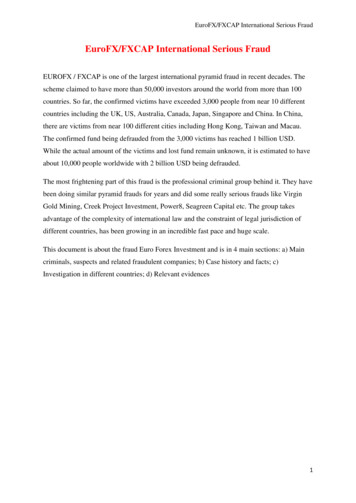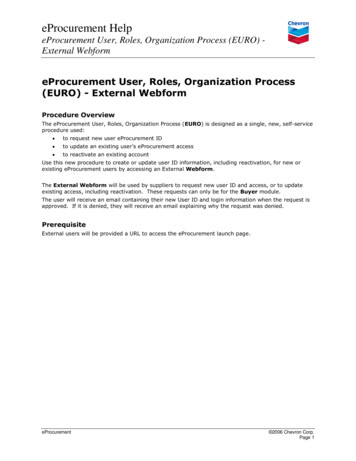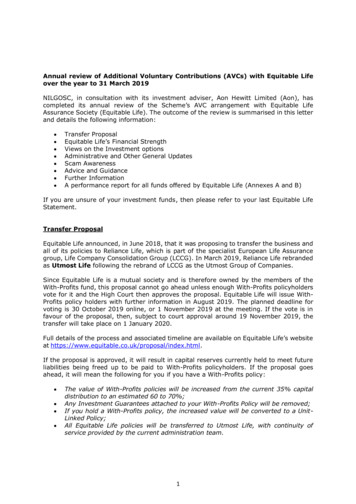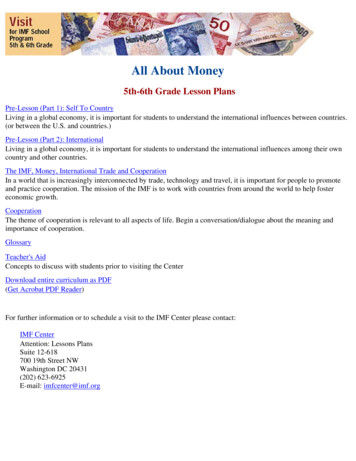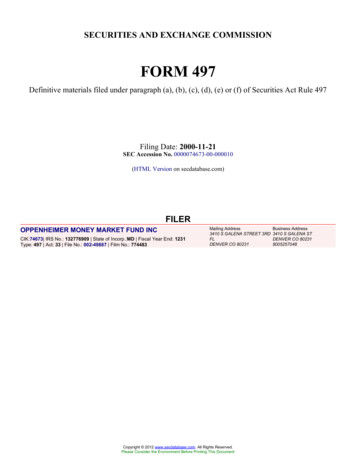
Transcription
E U RO M O N E Y M A R K E T S tu dyD E C E M B E R 2012
EURO MONEY MARKET STUDYD e c em b er 2012In 2012 all ECBpublicationsfeature a motiftaken fromthe 50 banknote.
European Central Bank, 2012AddressKaiserstrasse 2960311 Frankfurt am MainGermanyPostal addressPostfach 16 03 1960066 Frankfurt am MainGermanyTelephone 49 69 1344 0Websitehttp://www.ecb.europa.euFax 49 69 1344 6000All rights reserved. Reproduction foreducational and non-commercial purposesis permitted provided that the source isacknowledged.ISSN 1830-3781 (online)
CONTENTSCONTENTSExecutive summary 51 Introduction 72 The monetary policy environment in 2011 and 2012 83 The unsecured market 163.1 Turnover analysis 3.2 Maturity analysis 3.3 Market structure 1620214 The secured market 234.14.24.34.4Turnover analysis Maturity analysis Market structure Triparty repos 232425305 Developments in the over-the-counter derivatives markets 315.1 Turnover analysis 5.2 Maturity analysis 5.3 Market structure 3132386 The short-term interest rate futures and options markets 437 The short-term securities market 487.1 Analysis of turnover in the secondary market 7.2 Outstanding amounts and issuance 7.3 Market structure 4854558 Cross-market segment analysis 568.1 Turnover analysis 8.2 Maturity analysis 8.3 Market structure 5761629 Putting the EMMS into perspective – volume data 71boxes1 The ECB’s non-standard measures and the financial crisis 2 Changes in collateral eligibility requirements and risk control measures and developmentsin the use of collateral in Eurosystem monetary policy operations 3 New data regarding the perceived impact of counterparty limits on money markets 4 Development of the secured money market against the background of non-standardmonetary policy measures – new evidence from Euro GC Pooling 5 The FX swap market: some evidence of pricing and currency breakdownduring the crisis 6 US and European money market funds during the crisis 7 The Eurosystem’s position on EURIBOR reform 9131726364046ECBEuro Money Market StudyDecember 20123
8 The French certificate of deposit (CDs) and commercial paper (CPs) markets 9 Segmentation in the euro money market and the impact of the ECB’s most recentnon-standard measures 10 Impact of the zero deposit facility rate on the euro money market 495765AnnexesAnnex 1: Credit institutions participating in the EMMS 2012 Annex 2: Technical annex Annex 3: A comparison of the International Capital Market Association EuropeanRepo Council (ICMA ERC) survey and the ECB survey on euro interbankmoney market activity Annex 4: Glossary Annex 5: Coordination of the 2012 Euro money market study 4Abbreviations used for country namesAbbreviations used in the lgiumBulgariaCzech ovakiaFinlandSwedenUnited KingdomSwitzerlandECBEuro Money Market StudyDecember 20127678818389central counterpartyforward rate agreementsswaps foreign exchange swapsother interest rate swapsovernight index swapsovernightover the countertomorrow/next (day)spot/next (day)securities short-term securitiescross-currency swapsNote: The data represented herein refer to thesecond quarter of each respective year.
E x e c ut i v esummaryExecutive summaryThis ninth study on the structure and functioning of the euro money market is based on a surveyconducted by the European Central Bank (ECB) and the national central banks that are members ofthe European System of Central Banks (ESCB).1 The survey asked panel banks (listed in Annex 1)to indicate their average daily turnover in various money market instruments during the secondquarters of 2012 and 2011 and to answer a number of qualitative questions. Three features of thisstudy are new compared with the previous studies: (i) a question on the impact of banks’ counterpartylimits on money market activity was introduced in the 2012 survey and is discussed in this study forthe first time (see Box 3); (ii) information is introduced about the currency breakdown of foreignexchange swap and forward transactions (see Box 5); and (iii) Section 9 discusses aggregate volumedata from the survey, released for the first time, complementing the regular indices of transactionvolumes.The main findings of the study show the significant impact of the euro area sovereign debt crisison the euro money market, as well as the effect of the Eurosystem’s extraordinary policy measures,aimed at restoring the functioning of the fragmented euro money market.Aggregate turnover for all instruments in the euro money market decreased by 14% in the secondquarter of 2012 compared with the second quarter of the previous year. After a significant increase inturnover in 2011, when the euro area banking sector’s excess liquidity was low, aggregate turnoverfell below 2010 levels in the second quarter of 2012. This decline can be attributed to the euro areadebt crisis and the related impairment of the interbank market, as well as to the high excess liquidityenvironment that prevailed in the euro interbank market as a result of the two three-year longerterm refinancing operations (LTROs) in December 2011 and February 2012.The most notable declines in turnover took place in the segment of overnight index swaps (OISs),where turnover declined by 50% in 2012, and in the unsecured market, where it contracted by 36%.Market activity in the unsecured market remains highly concentrated in the overnight segment (shareof more than 70%), while turnover in the segment beyond one month remains very limited (onlyaround 2% of total unsecured activity). The contraction in the unsecured market can be explainedby the general trend towards secured lending and by a shortening of maturities on the back ofgreater aversion to counterparty risk. At the same time the current high level of excess liquidity,provided by the Eurosystem, reduces the demand for interbank funding, while stricter regulationrequirements tend to reduce the supply of, particularly, unsecured interbank lending.The decline in money market activity was pronounced compared with the previous year, as thesecond quarter of 2011 was before the intensification of the euro area debt crisis, and excessliquidity had temporarily subsided and activity in the money market had picked up substantially.This effect is also very noticeable in the significant decline in the OIS segment. The environment ofhigh excess liquidity combined with the low level of interest rates (the rate on the deposit facilitywas close to zero during the reference period) and the low volatility of overnight interest rates(as measured by the euro overnight index average or EONIA) significantly reduced the need tohedge interest rate risk.The secured market remained the largest segment of the euro money market, although turnoverdeclined by 15% in the second quarter of 2012. The decline was driven by a 26% decrease in activityfor the overnight maturity, which represents around 18% of total secured turnover. The share of1The ESCB consists of the ECB and the national central banks of the European Union (EU) Member States.ECBEuro Money Market StudyDecember 20125
secured market activity cleared through central counterparties (CCPs) increased further, to 55% oftransactions (compared with 51% in 2011). Whereas in previous years activity in the CCP markethad picked up considerably after more European banks joined the international repo platforms,in 2012 CCP repo business declined (albeit at a slower rate than overall repo transactions), on the backof, among other factors, increased margin requirements following rating downgrades and increasingyields of some peripheral euro area debt. Overall, business also declined as many banks had alreadyfulfilled their funding needs for 2012 with the liquidity received from the Eurosystem’s LTROs.The continued decline in the share of unsecured lending, as well as the increase in the share oftransactions settled through CCPs, indicates heightened concerns about counterparty risk. On theother hand, the geographical structure of both the counterparties and the collateral shows only somesigns of a preference for domestic counterparties and collateral (a “home bias”). In the unsecuredmarket the share of domestic counterparties increased significantly, from around 28% in 2011to around 39% in 2012, while for the secured market the share of domestic collateral increasedslightly, from 26% to around 31%. There has been a slight trend away from domestic collateralsince 2009 – partly related to the euro area debt crisis – as repo investors are often less willing toenter into repos with collateral issued in the country of the counterparty if that country has elevatedsovereign and counterparty risk (“wrong way” correlation risk).The only market segment where activity picked up significantly (by 12%) was the market for FXswaps, as these remained an important cash funding tool for European banks. Since they are consideredmore secure – not least as they are settled mainly via large multicurrency cash settlement systems –they have profited from the move away from unsecured transactions. Another sign of the resilienceof the FX swap market is the fact that it has been able to accommodate the demand for a lengtheningof maturities as banks have tried to term out their money-market funding in foreign currencies. Thebroader use of e-commerce platforms continued to support activity in this market segment, with thesurvey showing an increase in the share of electronic trading in most market segments.Turnover in the outright secondary market for short-term securities declined by 9% for the segmentas a whole, whereas turnover in short-term paper issued by credit institutions increased by 12%,a trend that may have been indirectly supported by an increase in the outstanding amount ofSTEP (Short-Term European Paper) in the second quarter of 2012. Some of this increase in STEPcould potentially be explained by the eligibility of these short-term securities as collateral for theEurosystem’s operations.The qualitative part of the survey shows that respondents considered the efficiency of the unsecuredmarket to have declined markedly in comparison with 2011. Liquidity conditions in the interbankmoney market were also perceived to have deteriorated, possibly in part because of the Eurosystemtaking on an increased intermediary role with its three-year LTROs and, for some segments, thelower volatility due to the high level of excess liquidity reducing hedging needs. As regards thesecured segment, the number of respondents giving a positive assessment of the market’s efficiencyincreased, although liquidity conditions were perceived as being worse than in 2011. For most othermarket segments, the perception of efficiency was more positive in 2012, whereas it was generallyfelt that liquidity conditions had deteriorated.The results of the new qualitative question on credit limits showed that nearly half of surveyparticipants assessed changes in their risk limits vis-à-vis their counterparties to have had acontractionary impact on current money market activity in terms of turnover; for the future, surveyparticipants foresee a slowdown of this deterioration process.6ECBEuro Money Market StudyDecember 2012
I Introdu c t i on1 IntroductionIn the second quarter of 2012, the ECB and the national central banks (NCBs) of the ESCBconducted a quantitative and qualitative survey of the euro money market among banks in the27 EU countries and one non-EU country.2 This was undertaken under the auspices of the MarketOperations Committee of the ESCB and with the general support of the Money Market ContactGroup of the ECB.On the basis of that survey, the 2012 Euro money market study analyses the euro money marketin terms of trends and developments in its integration and efficiency, following on from similarstudies conducted in the second quarters of 1999, 2000, 2001 and 2002, and biennially since then.The 2012 study covers the second quarters of 2011 and 2012, with each participating bank reportingthe daily average turnover in each of the money market segments during these two periods. EachNCB selected a number of banks with a view to obtaining a representative coverage of euro moneymarket activities. Altogether, a total of 172 banks participated in the survey. The country breakdownof the participating banks is shown in Table 1 (for a detailed list of participating banks see Annex 1).The methodological notes contained in the questionnaire can be found in Annex 2.Compared with 2011, the panel of 172 banks represents a net increase by two counterparties.Estonia is represented in the survey for the first time, with three banks. One more Italian bank, onemore Maltese bank and two more Swiss banks were added, while two Spanish banks, one Greekbank, one British bank and one Lithuanian bank were no longer included.The purpose of the study is to highlight the main trends affecting the structure of the euro moneymarket. For the convenience of users, this study for the first time releases absolute turnover data,as well as additional information that is useful to keep in mind when interpreting the turnoverdata. The survey is based not only on turnoverdata but also features qualitative questions, theTable 1 Country breakdown of participatingbanks in 2012results of which are weighted by the turnoverdata provided by the respondents. The numberof banks participating in the successive annualAustria8Latvia4Belgium3Lithuania3surveys varies slightly and also changes fromBulgaria4Luxemburg3one market segment to another, as not all banksCyprus3Malta5are active in all segments of the money market.Czech Republic8Netherlands6Hence two types of samples were used for theDenmark1Poland12Estonia3Portugal14analysis, depending on the time frame. TheFinland2Romania3first sample group, which was used to analyseFrance9Slovakia2the evolution of the euro money market overGermany17Slovenia3the last two years, includes all reporting banksGreece7Spain13Hungary3Sweden3(i.e. 172 banks). The second group, which wasIreland6Switzerland3used for a longer-term analysis of the periodItaly8United Kingdom16since 2002, includes 105 banks and is called theTotal172“constant panel of banks”.323Three panel banks are from Switzerland.When the survey was first conducted in 2000 the constant panel consisted of 85 banks. In the 2006 study, 29 banks were added to thisconstant panel for the period from 2002 onwards to make the analysis more complete. Some further modifications were made to theconstant panel in the euro money market study of 2008, when it was reduced from 114 to 109 banks: seven banks which had not taken partin the survey since 2006 were removed and two others added. In 2009, as a consequence of mergers among members of the constant panel,the number formally dropped to 105. The composition of the constant panel is the same for all market segments.ECBEuro Money Market StudyDecember 20127
Finally, in addition to the results of the Euro money market survey (EMMS), other data sourceshave been used. The section on the monetary policy environment in 2011 and 2012 (Section 2)elaborates on data from the ECB on the use of the deposit facility and the use of collateral inEurosystem monetary policy operations. The section on the secured market (Section 4) draws ondata from the International Capital Market Association (ICMA) survey; Box 4 draws on data fromEurex Repo. The box on money market funds in Section 5 uses some data from Fitch Ratings; thefutures and options markets section (Section 6) relies also on data published by New York StockExchange - London International Financial Futures and Options Exchange (NYSE.liffe Euronext)and for EURIBOR data on the European Banking Federation (EBF); the section on the short-termsecurities market (Section 7) analyses data from ECB securities issues statistics, ECB Short-TermEuropean Paper (STEP) statistics, the Banque de France and Dealogic; finally the section on crossmarket analysis (Section 8) includes data from Bloomberg.2The monetary policy environment in 2011 and 2012Against the backdrop of higher energy and commodity prices and a positive underlying momentumof economic growth, the Governing Council of the ECB raised its policy rates by 25 basis pointsin both April and July of 2011, the first changes since May 2009. This brought the minimum bidrate on the main refinancing operations (MROs) to 1.50% and the rates on the marginal lending anddeposit facilities to 2.25% and 0.75% respectively (see Chart 1). As financial market conditionsdeteriorated and inflationary pressures eased, the Governing Council implemented two consecutive25 basis points reductions in its key interest rates, in November and December 2011. Policy ratesremained unchanged until July 2012, when the Governing Council reduced its policy rates by afurther 25 basis points to a new record low, amid continued dampening of inflationary pressuresover the policy-relevant horizon. This decision brought the rate on the MROs down to 0.75% andthe rates on the marginal lending and deposit facilities to 1.50% and 0.00% respectively. The widthof the interest rate corridor has remained unchanged since May 2009 at 150 basis points.In addition to adjusting interest rates to ensure price stability over the medium term, the ECBcontinued to implement a number of non-standard policy measures to repair the monetary policytransmission mechanism (see Box 1). The fixed rate tender procedure with full allotment for MROsand longer-term refinancing operations (LTROs) was extended until at least 9 July 2013. As banks’funding conditions deteriorated amid heightened financial market tensions, the ECB conducted itsfirst ever three-year LTRO in December 2011, which was followed by a second in February 2012.The Governing Council announced measures to increase collateral availability in December 2011,and in June and September 2012. In addition, in December 2011 the Governing Council halved thereserve requirement ratio from 2% to 1% of relevant liabilities.In October 2011, the Governing Council announced a second covered bond purchase programmefor the intended amount of 40 billion. The Securities Markets Programme (SMP) remained inplace throughout most of the review period, but was terminated on 6 September 2012 following theGoverning Council’s decision to introduce Outright Monetary Transactions (OMTs), i.e. outrighttransactions in secondary sovereign bond markets with the aim of safeguarding an appropriatemonetary policy transmission and the singleness of the ECB’s monetary policy. OMTs willenable the ECB to address severe distortions in government bond markets which originate from,in particular, unfounded fears on the part of investors of the reversibility of the euro.8ECBEuro Money Market StudyDecember 2012
The level of excess liquidity 4 increased sharplyfollowing the three-year LTROs conducted inlate 2011 and early 2012, rising from just over 100 billion at the end of 2010 (when the lastEuro money market study was published) toover 775 billion at the end of June 2012(the closing date of the 2012 survey). As a resultof ample liquidity conditions, the effective lowerbound for the euro overnight index average(EONIA) has been the rate on the ECB’s depositfacility rather than the rate on the MROs(see Chart 1). In addition, EONIA volatilitydeclined in response to the significant excessliquidity. Following the cut in the deposit facilityrate to 0.00% in July 2012, EONIA has fixed atnew record lows. Other euro money marketrates, such as EURIBOR and EUREPO, havealso hit new record lows. Nevertheless, moneymarkets have remained largely impairedthroughout 2011 and 2012 and the ECB hascontinued its intermediation role.4chart 1 Evolution of key Ecb interest ratesand EONiA2 ThE MONETARYpOlicY ENviRONMENTiN 2011 AND 2012(percentages)main refinancing operationsmarginal lending facilitydeposit Apr.July2011Oct.Jan.Apr.2012July0.0Sources: ECB and EBF.Excess liquidity is calculated as the net use of standing facilities (deposit facility less marginal lending facility) plus excess reserves(current account balances less reserve requirements).box 1ThE Ecb’S NON-STANDARD MEASURES AND ThE fiNANciAl cRiSiSSince the onset of the current financial crisis, in mid-2007, the ECB has adopted severalnon-standard monetary policy measures to address severe tensions in financial markets. Themain goal of these measures has been to maintain an effective transmission mechanism ofmonetary policy, also ensuring that the monetary policy stance is transmitted evenly acrossall jurisdictions of the euro area. In this respect one can distinguish between a set of primarilybank-based measures introduced to enhance the flow of credit beyond what could beachieved through the standard interest rate channel and those measures addressing the severemalfunctioning in the price formation process in the bond markets of euro area countries.In particular, this box will elaborate on the introduction or extension of credit support measuresaimed at the financial sector, i.e. the fixed rate full allotment procedure in Eurosystem liquidityproviding operations, the policies aimed at collateral availability, the longer-term refinancingoperations, the FX swaps with other central banks and the covered bond purchase programme.It will then also summarise the development over time of the SMP and the announcement of theOMTs, targeted at the malfunctioning in sovereign bond markets.ECBEuro Money Market StudyDecember 20129
Fixed rate full allotment regimeSince the publication of the last money market study in December 2010, the ECB hassuccessively announced the extension of the fixed rate full allotment regime initially introducedin October 2008 for all MROs, special-term refinancing operations with a maturity of onemaintenance period, and LTROs. In the case of the LTROs, the rate is fixed at the average rateof the MROs conducted during the life of the respective LTRO. The last announcement in thisregard dates from 6 December 2012, when the ECB said it would extend this regime at least until9 July 2013.Collateral rulesAlso since the publication of the last Euro money market study, the ECB has decided on anumber of changes in collateral eligibility requirements and risk control measures. Such changesinclude refinements to the Eurosystem collateral framework for the implementation of monetarypolicy but also measures to expand the framework in order to increase collateral availability forcounterparties. For a detailed description of the changes in collateral eligibility requirements andthe use of collateral in Eurosystem monetary policy operations see Box 2.Longer-term refinancing operationsAfter the introduction of very long-term operations and the subsequent conduct of three oneyear longer-term refinancing operations (LTROs) in 2009 additional non-regular LTROs wereconducted and the maturity was further lengthened. These decisions were aimed at enhancingcredit support by providing stable and longer-term bank funding. More specifically, on4 August 2011 the ECB announced a six-month LTRO. On 6 October 2011 two additionalLTROs were announced, one with a maturity of around 12 months to take place in October 2011and the other with a maturity of approximately 13 months to take place in December 2011.On 8 December 2011, the ECB announced the conduct of two three-year LTROs, one in December2011 and the other in February 2012, with the embedded option of early repayment after oneyear.1Swap agreements with other central banksOn 15 September 2011 the ECB announced, in coordination with other major central banks,the re-introduction of three-month US dollar liquidity-providing operations covering the end ofthe year, with the same procedure as for the weekly seven-day US dollar liquidity-providingoperations. These operations were initially introduced in October 2008 to address elevatedpressures in the short-term US dollar funding markets. They continued to be carried out as fixedrate full allotment tenders in the form of repurchase agreements against collateral eligible forEurosystem credit operations. On 30 November 2011 the swap agreement with the FederalReserve System had been further extended until 1 February 2013. Also, the pricing on theexisting temporary US dollar liquidity swap arrangements was lowered by 50 basis points, whichresulted in a spread of 50 basis points over the US dollar OIS rate.1 The first date for early repayment of the first three-year LTRO is 30 January 2013. This first three-year LTRO replaced the secondone-year operation of 2011 as initially announced on 6 October 2011; the ECB also gave banks the option to shift the amounts obtainedin the one-year LTRO settled in October 2011 into the first three-year LTRO.10ECBEuro Money Market StudyDecember 2012
In addition, on 30 November 2011 the ECB, together with the Federal Reserve System, the Bankof England, the Bank of Canada, the Bank of Japan and the Swiss National Bank, announced theestablishment of temporary bilateral liquidity swap arrangements in order to provide liquidity ineach jurisdiction in any of their currencies if market conditions so justified. On 13 December 2012the ECB extended these existing swap agreements with other central banks until 1 February 2014.2 The monetarypolicy environmentin 2011 and 2012Covered bond purchase programmeThe aim of the covered bond purchase programme (CBPP), first introduced in May 2009, hasbeen to support a specific financial market segment that is important for the funding of banksand that had been particularly affected by the financial crisis. Purchases under the first CBPP,with an intended amount of 60 billion, were completed in June 2010. On 6 October 2011, theGoverning Council announced a new covered bond purchase programme (CBPP2) under whichthe Eurosystem would directly purchase covered bonds in the primary and secondary markets foran intended amount of 40 billion between November 2011 and October 2012. The Eurosystemcentral banks intend to hold these covered bonds until maturity.Other measuresOn 8 December 2011 the ECB announced the discontinuation of the fine-tuning liquidityabsorbing operations which had been carried out on a regular basis on the last day of reservemaintenance periods. In addition, the reserve ratio was halved from 2% to 1%. As a consequenceof the full allotment policy applied in the ECB’s main refinancing operations and the way bankswere using this option, the system of reserve requirements was not needed to the same extent asunder normal circumstances to steer money market conditions.Securities Markets ProgrammeBesides these primarily bank-based enhanced credit support measures designed to tackle themalfunctioning of the transmission mechanism in the financial sector, the ECB also adoptedadditional non-standard monetary policy measures to address the severe malfunctioning in theprice formation process in the bond markets of euro area countries.The Securities Market Programme (SMP), announced on 10 May 2010, remained in operationuntil 6 September 2012, when it was terminated following the introduction of OMTs. Alreadybetween March and August 2011 and after February 2012 no purchases had been conductedunder the SMP. The liquidity injected through the SMP will continue to be absorbed throughthe weekly seven-day liquidity-absorbing operations and, in addition, the securities in the SMPportfolio will be held to maturity.Outright Monetary TransactionsThe ECB on 2 August 2012 announced that, within its mandate to maintain price stabilityover the medium term and in observance of its independence in determining monetary policy,it may undertake outright open market operations of a size adequate to reach its objective.On 6 September 2012 the ECB then announced the technical features for the possible implementationof Outright Monetary Transactions (OMTs), which are aimed at safeguarding an appropriatemonetary policy transmission and the singleness of its monetary policy. OMTs will enable theECB to address severe distortions in government bond markets which originate from, in particular,ECBEuro Money Market StudyDecember 201211
unfounded fears on the part of investors of the reversibility of the euro. Purchases will take place insecondary markets for sovereign bonds in the euro area, with a focus on the shorter end of the yieldcurve (maturities between one and three years) without any quantitative ceiling, and will be fullysterilised. OMTs are decided in full independence. Member States are only eligible for purchases ifthey are subject to the strict and effective conditionality attached to a European Financial StabilityFacility/European Stability Mechanism (EFSF/ESM) macroeconomic adjustment programme orprecautionary programme, or in the case of Member States already under an EU-IMF adjustmentprogramme, once a country has been regaining bond market access.Turning to monetary policy in the United States, the federal funds target rate has remained at0-0.25%, since December 2008. The discount rate for primary credit remains at 0.75%, unchangedsince February 2010. In September 2011, the Federal Open Market Committee (FOMC) of theFederal Reserve System announced a maturity extension programme, commonly known as“Operation Twist”, in order to put downward pressure on longer-term interest rates and help tomake broader financial conditions more accommodative. Under this programme, which initially ranfrom September 2011 to June 2012, the FOMC extended the duration of its balance sheet by sellingUSD 400 billion of shorter-term Treasury securities and buying an equal amount of longer-termTreasury securities. In June 2012, the FOMC extended this programme through the end of 201
on the euro money market, as well as the effect of the Eurosystem's extraordinary policy measures, aimed at restoring the functioning of the fragmented euro money market. Aggregate turnover for all instruments in the euro money market decreased by 14% in the second quarter of 2012 compared with the second quarter of the previous year.

